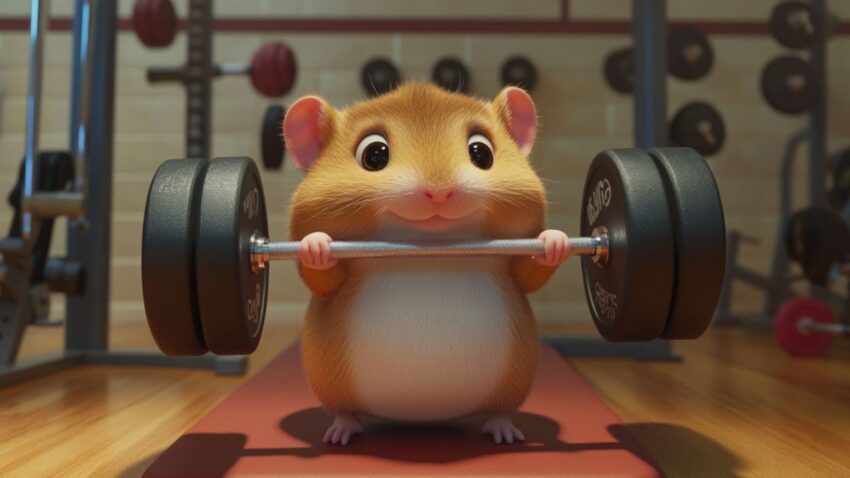If you’ve ever watched your hamster zip around their cage, scurry through tunnels, or sprint on their wheel, you’ve probably wondered—do hamsters actually work out? The answer is a resounding yes! These tiny creatures are naturally active and rely on movement to stay healthy, both physically and mentally.
In the wild, hamsters can travel several miles each night searching for food, digging tunnels, and avoiding predators. In captivity, however, they don’t have that luxury. That’s where a hamster gym comes in! A hamster gym is a dedicated space filled with climbing structures, tunnels, and exercise equipment designed to keep your pet engaged, fit, and entertained.
But just like us, not every hamster instinctively knows how to use gym equipment. Some may hesitate, while others may need a little coaching and encouragement to explore their new playground. That’s why training is key—it helps your hamster gain confidence, learn to navigate obstacles, and get the most out of their mini workout space.
Why Do Hamsters Need Exercise?
Exercise isn’t just about burning calories—it’s vital for your hamster’s overall health. A sedentary lifestyle can lead to obesity, boredom, and even stress-related behaviors like bar chewing or excessive digging.
Benefits of Regular Exercise for Hamsters:
✔️ Prevents obesity – Hamsters can easily gain excess weight if they’re not active.
✔️ Boosts mental stimulation – Exploring a gym mimics the natural foraging and climbing behaviors they’d do in the wild.
✔️ Reduces stress and boredom – A bored hamster is a destructive hamster! A gym provides healthy outlets for energy.
✔️ Encourages natural movement – Running, climbing, and tunneling help maintain strong muscles and a healthy heart.
So, while your hamster might not be lifting tiny dumbbells anytime soon, a well-designed hamster gym can give them the workout they need to stay happy and healthy.
What Is a Hamster Gym?
A hamster gym is a designated area inside (or outside) their enclosure filled with exercise-based toys and equipment. Think of it as a mini playground for your hamster!
Common Features in a Hamster Gym:
✔️ Exercise Wheels – The classic hamster treadmill for cardio workouts.
✔️ Tunnels and Tubes – Encourages burrowing instincts and exploration.
✔️ Climbing Structures – Ramps, ladders, and platforms for strength training.
✔️ Obstacle Courses – DIY mazes and bridges for mental stimulation.
✔️ Digging Boxes – A designated space for burrowing, a natural hamster behavior.
Whether you buy a pre-made hamster gym or build a DIY setup from cardboard and wooden sticks, the goal is to provide variety and challenge to keep your hamster physically and mentally engaged.
Why Training Is Essential for a Hamster Gym
Not all hamsters will instantly know what to do with their new gym setup. Some may cautiously sniff around, while others might ignore it completely. Training helps them learn to use equipment safely, gain confidence, and fully enjoy their environment.
Why Training Matters:
✔️ Prevents fear and hesitation – A hamster that is unsure about an obstacle may avoid it entirely.
✔️ Teaches them how to use equipment safely – Climbing structures and tunnels should be introduced gradually.
✔️ Encourages natural behaviors – Training reinforces foraging, climbing, and digging instincts in a controlled way.
The best part? Training a hamster to use a gym is fun for both you and your pet! Watching them master an obstacle course or tackle a climbing structure is rewarding—and it strengthens your bond with them.
Why a Hamster Gym? The Science of Exercise for Hamsters

Hamsters may be small, but their need for exercise is huge! In the wild, they’re constantly on the move—running for miles each night to search for food, dig tunnels, and escape predators. In captivity, however, their world is much smaller, and without enough activity, they can develop health problems and stress-related behaviors.
That’s where a hamster gym comes in. A well-designed gym gives your furry friend a safe space to climb, run, burrow, and explore, helping them stay fit and mentally engaged. But this isn’t just about fun—there’s real science behind why exercise is crucial for a hamster’s physical and mental well-being. Let’s break it down!
How Exercise Keeps Hamsters Happy and Healthy
Just like humans, hamsters need regular exercise to stay healthy, active, and mentally sharp. Without movement, they can become overweight, sluggish, and even depressed—yes, hamsters can experience boredom-induced stress!
The Benefits of Exercise for Hamsters
✔️ Prevents Obesity – Hamsters in captivity don’t have to hunt for food, so they can easily overeat and gain weight. Exercise helps burn excess calories and maintain a healthy body weight.
✔️ Promotes Cardiovascular Health – Running on a wheel or climbing obstacles gets their tiny hearts pumping, improving circulation and overall fitness.
✔️ Enhances Mental Well-being – Studies on rodent activity levels show that exercise reduces anxiety and promotes problem-solving skills.
✔️ Encourages Natural Instincts – Hamsters love to burrow, climb, and explore—a gym lets them express these behaviors in a safe space.
Scientific Studies on Hamster Exercise
A 2016 study published in Behavioural Brain Research found that rodents with access to exercise wheels showed reduced anxiety and improved cognitive function compared to sedentary rodents. The study also linked increased physical activity to better stress management, proving that movement is essential for mental well-being.
Another study from The Journal of Experimental Biology discovered that hamsters run an average of 5-9 km (3-5 miles) per night in the wild. In captivity, a hamster without a gym or wheel can become frustrated, lethargic, and prone to destructive behaviors.
This is why a hamster gym isn’t just a luxury—it’s a necessity for keeping your pet happy and healthy!
Preventing Cage Stress and Boredom Behaviors
A hamster stuck in a small cage with nothing to do can quickly become stressed and destructive. Without enough stimulation, they may start displaying stress-related behaviors, such as:
Bar Chewing – Gnawing on cage bars out of frustration.
Excessive Digging – Digging aimlessly at the corners of the cage.
Pacing or Running in Circles – Repetitive movement caused by boredom.
Aggressive Behavior – Biting cage mates (if housed together) or resisting handling.
A hamster gym helps redirect this excess energy into healthy activities, providing both physical exercise and mental stimulation.
Case Study: How a Hamster Gym Reduced Stress Behaviors
Meet Peanut, a Syrian hamster who used to chew his cage bars every night, dig aggressively in his bedding, and seem restless even after running on his wheel. His owner, Mia, noticed these behaviors and decided to introduce a hamster gym with climbing structures, tunnels, and a digging box.
After one week – Peanut started exploring the new obstacles, sniffing around cautiously.
After two weeks – He spent less time chewing the cage bars and more time climbing ramps and tunnels.
After a month – His stress behaviors had completely disappeared, and he seemed more active and content.
This transformation shows that enrichment plays a crucial role in reducing stress and promoting natural behaviors!
Do Different Hamsters Need Different Exercise?
Not all hamsters have the same energy levels, body size, or exercise preferences. The type of gym setup that works for a Syrian hamster may not be ideal for a Dwarf hamster—so it’s important to tailor their gym to their unique needs.
Syrian Hamsters: The Solo Gym Enthusiasts
✔️ Larger Size, Bigger Gym Equipment – Syrians are bigger and heavier, so they need sturdier ramps, bridges, and climbing structures.
✔️ Enjoy More Climbing & Running – Syrians love to explore vertically, so multi-level gyms with platforms and ladders are great.
✔️ Prefer Exercising Alone – Syrians are solitary by nature, so their gym should be designed for solo workouts.
Best Gym Equipment for Syrians:
- 12-inch exercise wheel (to prevent back strain)
- Sturdy ramps and climbing walls
- Large tunnels and tubes (avoid ones that are too small)
Dwarf Hamsters: The Fast & Agile Explorers
✔️ Smaller Size, Tighter Spaces – Dwarf hamsters love squeezing through tiny tunnels and mazes.
✔️ More Social, Enjoy Group Play – If housed together, Dwarfs may chase each other through tunnels and climb together.
✔️ Quick & Agile Runners – They prefer low-height, fast-paced courses rather than tall structures.
Best Gym Equipment for Dwarfs:
- Smaller, low-height climbing areas
- Interconnected tunnels and hideouts
- Lightweight bridges and stepping stones
Setting Up the Perfect Hamster Gym
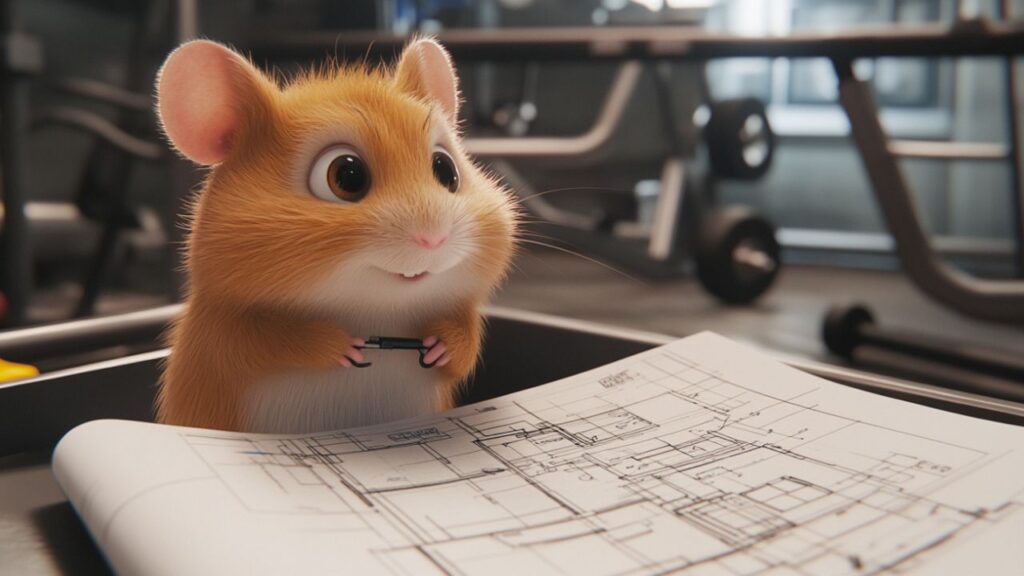
Now that we know why a hamster gym is essential, let’s dive into how to create the ultimate play zone for your tiny athlete! A well-designed hamster gym provides the right balance of physical exercise and mental stimulation, helping your hamster stay active, happy, and healthy.
Whether you go for a store-bought setup or a fun DIY creation, the key is to ensure that every piece of equipment is safe, engaging, and suited to your hamster’s size and personality.
What Equipment Belongs in a Hamster Gym?
A hamster gym should include a mix of activities to keep things exciting. Some hamsters love running and climbing, while others prefer digging and exploring tunnels. The best gyms include a variety of exercise and enrichment options to mimic natural behaviors.
✔️ Exercise Wheels (The Hamster Treadmill!)
- The most important piece of gym equipment—hamsters are natural runners and need a properly sized wheel for their daily cardio.
- A wheel that’s too small can cause back strain, leading to spinal issues.
- Best Wheel Sizes:
- Syrian Hamsters: 10-12 inches
- Dwarf Hamsters: 6-8 inches
Avoid: Wire mesh wheels (they can trap tiny feet!)—stick to solid surface wheels like plastic or cork-lined options.
✔️ Climbing Structures (For Strength & Coordination)
Hamsters love to climb, and adding ramps, ladders, and platforms to their gym lets them exercise their muscles while improving balance.
Best Climbing Structures:
✔️ Wooden Ramps & Bridges – Encourage natural climbing movements.
✔️ Stacked Platforms – Create a fun multi-level play area.
✔️ Ladders & Rope Bridges – Add variety and a sense of adventure.
Pro Tip: Make sure platforms and bridges have gentle slopes and textured surfaces to prevent slipping.
✔️ Tunnels & Tubes (For Cardio & Exploration!)
Hamsters in the wild dig intricate tunnel systems to stay safe and explore their environment. Adding tunnels to their gym satisfies their natural burrowing instincts and keeps them engaged in active movement.
Best Tunnel Options:
✔️ Plastic Tubes – Store-bought, easy to clean, and great for modular setups.
✔️ Cardboard Tubes – Cheap, chewable, and biodegradable!
✔️ Burrow Boxes – A box filled with bedding where hamsters can dig and hide.
Avoid tubes that are too small for your hamster’s size—Dwarf hamsters need at least a 1.5-inch diameter, while Syrians need at least 2.5 inches.
✔️ Obstacle Courses (For Mental & Physical Agility!)
An obstacle course turns your hamster’s gym into a real training ground! It combines physical exercise with problem-solving skills, encouraging them to climb, crawl, and jump.
Easy DIY Obstacle Course Ideas:
✔️ Toilet paper roll tunnels – Create a maze by cutting openings in each roll.
✔️ Small seesaws – A lightweight piece of wood balanced on a cork makes a fun challenge.
✔️ Hollowed-out coconut shells – Great for hiding treats and encouraging exploration.
Pro Tip: Change the layout of the obstacle course every few weeks to keep things fresh and exciting!
️ DIY vs. Store-Bought: Which Gym Setup is Best?
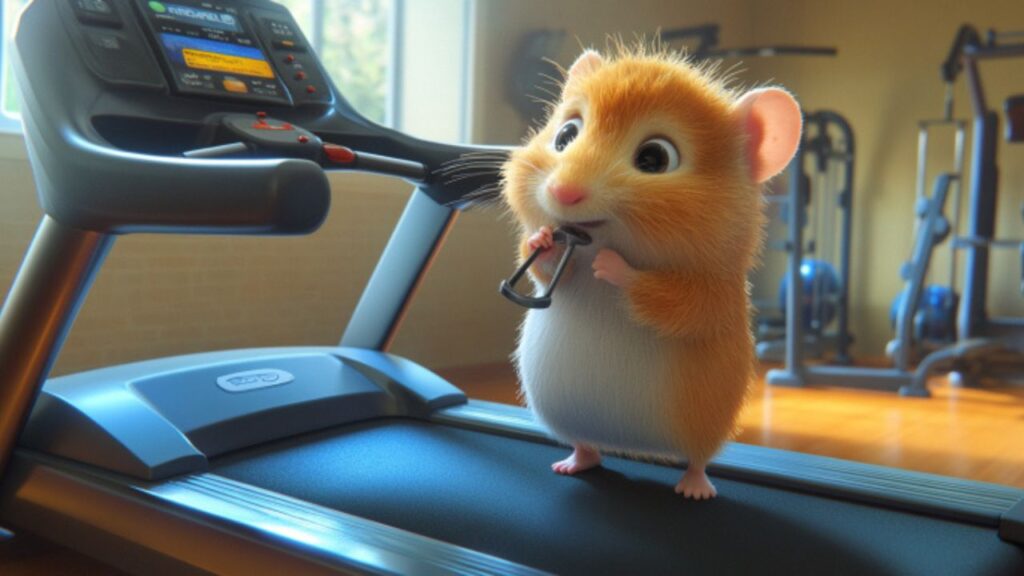
When it comes to building a hamster gym, you have two main options:
Buying a pre-made gym from a pet store
Building your own DIY gym from household materials
Each option has pros and cons, so let’s compare them!
| Option | Pros | Cons |
|---|---|---|
| Store-Bought Hamster Gym | ✅ Professionally designed for hamsters ️ ✅ Durable materials ️ ✅ Easy to set up ⏳ |
❌ Can be expensive ❌ Limited customization ❌ May not fit all cage sizes |
| DIY Hamster Gym | ✅ Cheap and budget-friendly ✅ Fully customizable ✅ Made from safe, hamster-friendly materials |
❌ Requires time and effort ⏳ ❌ Needs to be replaced more often ️ ❌ Must check for safety risks ⚠️ |
Fun DIY Hamster Gym Ideas!
Want to create a budget-friendly hamster gym at home? Here are some fun and easy DIY ideas using safe household materials!
- Toilet Paper Roll Maze – Cut small holes in paper towel rolls and stack them like a hamster-sized jungle gym!
- Cardboard Climbing Tower – Stack layers of cardboard with small ramps for a climbing challenge.
- Popsicle Stick Bridges – Glue popsicle sticks together to create a tiny balance beam or bridge.
- Digging Box – Fill a shallow plastic bin with bedding, sand, or shredded paper for burrowing fun!
- Tissue Box Hideout – Remove the plastic from a tissue box and turn it into a cozy tunnel or hideaway.
Pro Tip: If using glue for DIY projects, make sure it’s non-toxic and pet-safe—avoid strong adhesives that could be harmful if chewed!
Safety First: Ensuring a Secure Gym Environment
No matter how fun or creative your hamster gym is, safety should always come first. A poorly designed gym can lead to falls, injuries, or even escapes!
Avoiding Injuries: Gym Safety Checklist
✔️ Check for sharp edges – Sand down wooden surfaces to prevent splinters.
✔️ Secure all climbing structures – Avoid unstable platforms that can collapse.
✔️ Avoid small gaps – Hamsters can get stuck in tight spaces, causing stress or injury.
✔️ Choose non-toxic materials – If using glue or paint, make sure it’s pet-safe and chemical-free.
✔️ Ensure proper ventilation in tunnels – Avoid long, enclosed spaces that could trap air.
What to AVOID:
❌ Plastic hamster balls – These limit airflow and can cause overheating.
❌ Wheels with crossbars – Can cause spinal injuries if the hamster arches its back.
❌ Overly steep ramps – Hamsters have tiny legs—keep angles gentle!
Pro Tip: Regularly inspect the gym for wear and tear, especially if you have a chewer who might gnaw on structures. Replace any damaged pieces immediately!
Step-by-Step Guide: Training Your Hamster to Use a Hamster Gym

Now that your hamster gym is set up with wheels, tunnels, climbing structures, and obstacle courses, it’s time for the real fun—training your hamster to use it! While some hamsters will eagerly explore their new play space, others may be hesitant or unsure about using the equipment.
The key to successful training is patience, positive reinforcement, and gradual exposure. This step-by-step guide will help your hamster gain confidence, learn to navigate obstacles, and get the most out of their new gym.
Step 1: Introducing Your Hamster to the Gym
Before expecting your hamster to start climbing ramps and running through tunnels, you need to let them explore the gym at their own pace. Hamsters can be naturally cautious in new environments, so giving them time to investigate without pressure is crucial.
How to Let Your Hamster Explore Without Overwhelming Them
Start Slow:
✔️ Place your hamster inside the gym area, but don’t force them onto any equipment.
✔️ Let them sniff, walk around, and get used to their surroundings.
✔️ Keep the first session short—just 5-10 minutes to avoid overstimulation.
Watch for Comfort Signs:
✔️ If your hamster sniffs, climbs, or enters a tunnel, they’re feeling curious and safe.
✔️ If they freeze, hide, or try to escape, they may need more time to adjust.
Pro Tip: If your hamster seems nervous, try placing a familiar item (like a small piece of their bedding) in the gym to make it smell like home!
Using Food-Based Encouragement
Food is one of the best tools for building confidence and encouraging exploration. If your hamster isn’t engaging with the gym, try using strategic treat placement to guide them through different obstacles.
How to Use Treats for Training:
✔️ Place treats inside tunnels to encourage them to go through.
✔️ Put a small treat on a platform to motivate them to climb.
✔️ Scatter tiny food pieces across the gym so they explore multiple areas.
Avoid Overfeeding! Use tiny treats (like a single sunflower seed or a few oats) to prevent weight gain while keeping the training rewarding.
Pro Tip: If your hamster is food-motivated, you can turn the gym into a mini scavenger hunt by hiding tiny treats around the area!
Step 2: Encouraging Movement with Positive Reinforcement
Even after exploring, some hamsters may still hesitate to climb ramps, cross bridges, or enter tunnels. This is where positive reinforcement comes in—rewarding them for any small progress they make.
Why Some Hamsters May Be Hesitant
Fear of heights – Some hamsters are naturally more ground-dwelling and may avoid climbing at first.
Lack of exposure – If your hamster has never seen a ramp, bridge, or seesaw, they might not understand how to use it.
Personality differences – Some hamsters are bold and adventurous, while others are shy and cautious.
How to Gently Encourage Exploration
Reward Any Interaction:
✔️ If your hamster sniffs a ramp, steps on a ladder, or enters a tunnel, reward them with a gentle voice cue (“Good job!”) and a small treat.
✔️ Even small movements, like one paw on a platform, should be rewarded at first.
Use a Clicker or Voice Cues for Training
- A clicker (or a consistent word like “Yes!” or “Good!”) can help your hamster associate exploring the gym with positive reinforcement.
- Example: If they climb onto a ramp, click immediately and offer a reward.
- Over time, they’ll learn that using the gym = something good happens.
Pro Tip: If your hamster is scared of heights, try lowering climbing platforms and gradually increasing the height over time.
️ Step 3: Gradually Increasing Complexity
Once your hamster is confidently using basic gym equipment, you can add new challenges to keep them engaged. Hamsters love novelty—switching things up will prevent boredom and encourage problem-solving!
How to Adjust Difficulty Levels Over Time
Change the Layout Regularly
✔️ Rearrange tunnels, platforms, and ramps every 1-2 weeks so the gym feels fresh and exciting.
✔️ Add new hideouts or climbing spots to encourage exploration.
Introduce More Advanced Obstacles
✔️ Small Seesaws – Encourages balance and coordination.
✔️ Mini Jumps – Use a soft ramp with a small gap to train jumping skills.
✔️ Taller Platforms – Slowly increase height to build climbing confidence.
Make It a Puzzle!
✔️ Hide treats inside tunnels or under small obstacles to encourage problem-solving skills.
✔️ Use a DIY hamster maze to promote curiosity and exploration.
Pro Tip: Keep training fun! If your hamster seems frustrated or uninterested, go back to simpler activities and try again later.
Common Training Challenges and How to Overcome Them
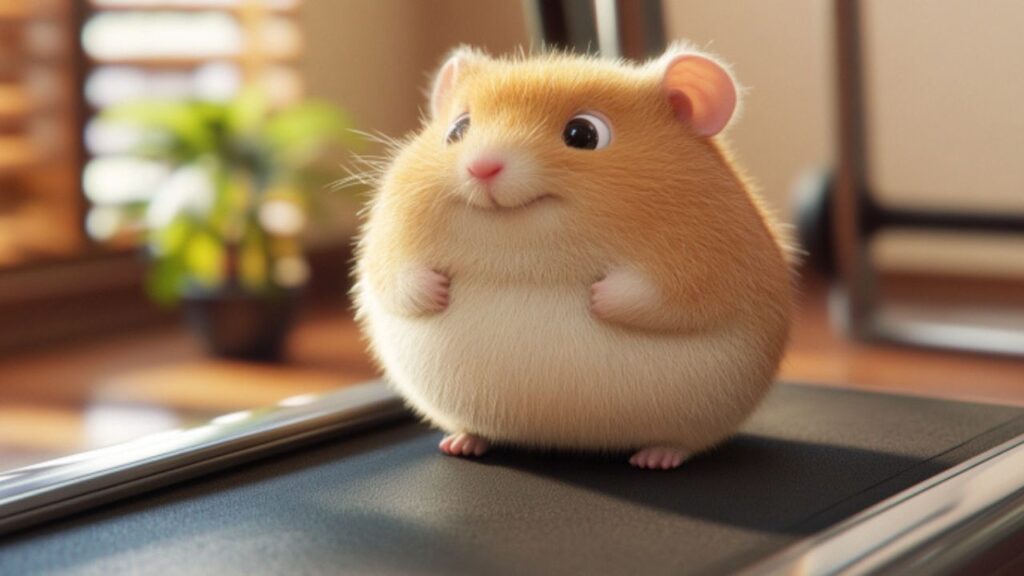
Training your hamster to use a hamster gym can be a fun and rewarding process, but like any form of training, it comes with its own set of challenges. Some hamsters may ignore the gym completely, while others may become overly obsessed with certain activities, leading to exhaustion. And of course, there are always the shy, cautious hamsters that need extra encouragement.
The good news? With the right adjustments and training techniques, you can help any hamster get the most out of their gym experience! Let’s go over some common training challenges and how to solve them.
What If My Hamster Ignores the Gym?
So, you’ve set up an amazing hamster gym, filled with tunnels, ramps, and climbing structures—only to find that your hamster completely ignores it. Don’t worry! There are a few reasons why this might happen.
Why Your Hamster Might Avoid the Gym
Fear of New Objects – Hamsters are naturally cautious and may take time to trust new things. If the gym is unfamiliar, they may avoid it at first.
Lack of Motivation – If your hamster is already getting enough exercise in other ways (such as running on their wheel), they may not see a reason to explore the gym.
Improper Setup – The gym might not be appropriately sized or suited to their needs. For example, Syrian hamsters may struggle with tunnels that are too small, while Dwarf hamsters might avoid steep climbing ramps.
Wrong Training Time – Hamsters are nocturnal or crepuscular (most active at dawn and dusk). If you introduce the gym during the day, they might be too sleepy to care.
✅ How to Get Your Hamster Interested in the Gym
✔️ Use Treat-Based Encouragement – Place small treats inside tunnels, on platforms, or near obstacles to entice them to explore.
✔️ Adjust the Layout – If they’re ignoring certain equipment, try moving pieces around, lowering ramps, or removing overly complex obstacles.
✔️ Introduce It Gradually – Start with one or two simple structures (like a tunnel or small bridge) before adding more equipment.
✔️ Train During Active Hours – Try gym time in the evening or early morning when your hamster is naturally alert and curious.
✔️ Use Familiar Scents – If they seem unsure, try rubbing their bedding on the equipment so it smells more familiar.
Pro Tip: If your hamster prefers a specific type of exercise (climbing vs. tunneling), focus on that first. Every hamster has different workout preferences!
Too Much Energy? Preventing Overuse of the Gym
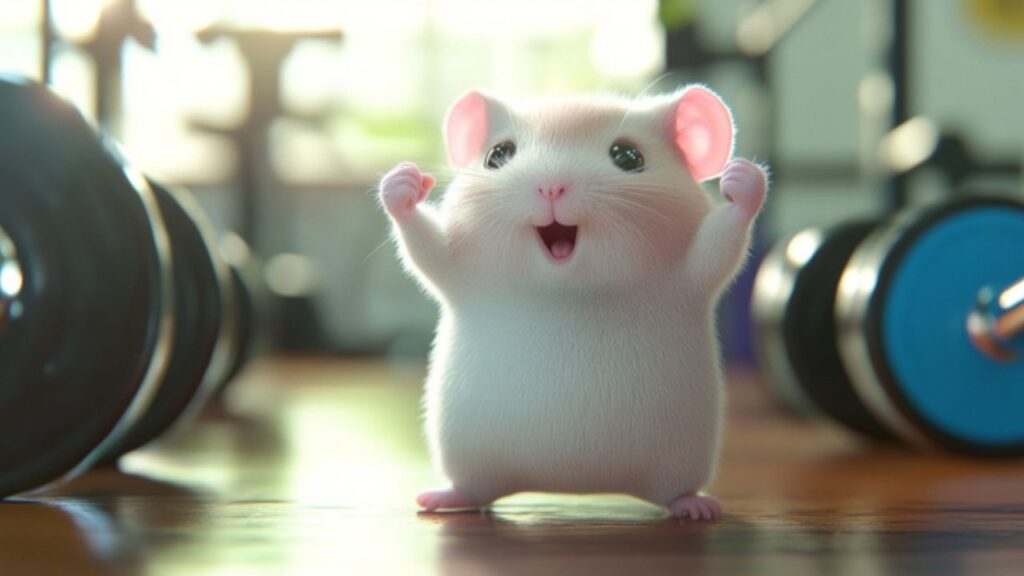
Most hamster owners worry about too little exercise, but what if your hamster loves the gym a little TOO much?
Some hamsters can become obsessed with certain equipment, leading to:
- Excessive running or climbing
- Skipping rest periods
- Unhealthy weight loss from too much activity
Signs Your Hamster May Be Overusing the Gym
- Running non-stop on the wheel for hours without taking breaks.
- Spending most of their waking hours on a single obstacle, ignoring food and water.
- Appearing fatigued but still continuing to climb or run.
- Losing weight despite eating normally.
How to Balance Gym Time with Rest & Relaxation
✔️ Limit Gym Access – Instead of leaving the gym open all the time, only allow access for short sessions (10-20 minutes) per evening.
✔️ Provide Cozy Rest Areas – If your hamster is over-exercising, make sure their cage has plenty of soft bedding and hideouts where they can relax.
✔️ Rotate Equipment – If they’re obsessed with one piece of gym gear (like the wheel), try temporarily replacing it with a different obstacle.
✔️ Ensure a Balanced Diet – Overactive hamsters burn more calories—make sure they have nutrient-rich food to maintain a healthy weight.
Pro Tip: If your hamster is running obsessively, check cage size and enrichment levels—they may be overusing the gym due to boredom or lack of space in their enclosure.
How to Train a Shy or Timid Hamster
Not all hamsters are natural athletes. Some are hesitant climbers, easily startled, or just naturally more cautious. If your hamster seems afraid of the gym, you’ll need to take a gentle, step-by-step approach to build their confidence.
Why Some Hamsters Are More Hesitant
Shy Personality – Some hamsters are naturally more reserved and prefer familiar surroundings.
Previous Negative Experiences – If they fell off a ramp or got stuck in a tunnel, they may avoid that equipment.
Fear of Open Spaces – Hamsters feel safest in enclosed areas. Large open platforms may make them nervous.
✅ Special Training Strategies for Shy Hamsters
✔️ Start Small & Slow – Instead of expecting them to climb ramps or tunnels right away, let them explore one simple obstacle at a time.
✔️ Create Safe Zones – Add small hideouts or enclosed tunnels within the gym so they have places to retreat if they feel nervous.
✔️ Lower Climbing Equipment – If they avoid ramps or platforms, try placing them closer to the ground and gradually increasing the height over time.
✔️ Use a “Guiding Path” of Treats – Place treats leading toward an obstacle to naturally encourage movement without forcing them.
✔️ Provide Extra Hiding Spots Nearby – If they’re hesitant to come out into the gym, place a small hideout or a covered tunnel entrance close to their cage exit.
Pro Tip: Some hamsters feel safer in darker environments—try dimming the lights when introducing the gym to see if they’re more comfortable exploring!
Hannah’s Training Tactics: Quick Tips for Success
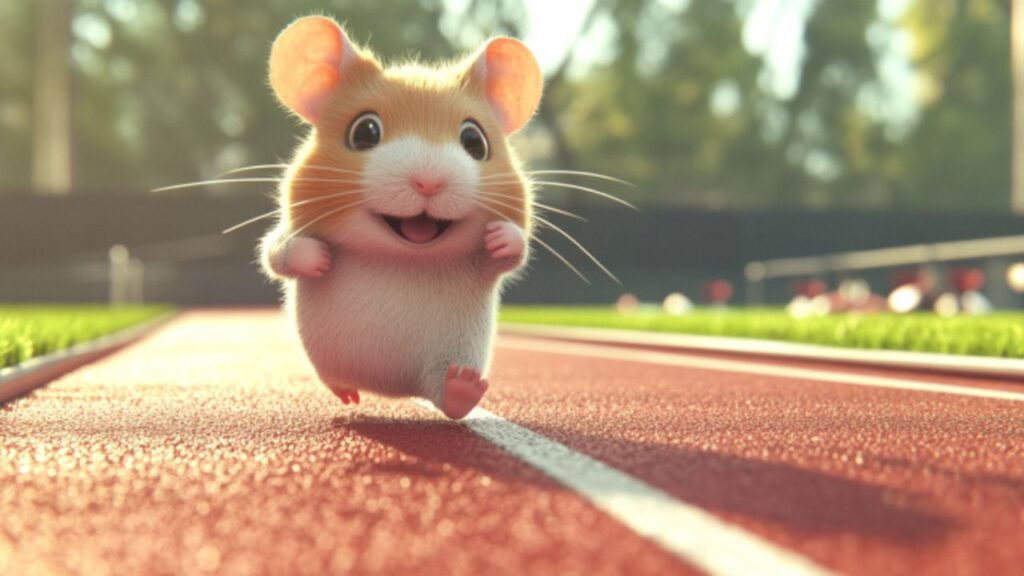
Training your hamster to use a gym should be a fun, engaging experience—not just for them, but for you too! Every hamster has their own personality and comfort level, which means some will jump right into their gym adventures, while others need a little more time and encouragement.
The key to success? Start small, observe their play preferences, and make the gym a dynamic, ever-changing experience! Here are my top quick, actionable training tips to help your hamster become a confident, active gym-goer.
Start Small—Introduce Equipment One at a Time
You wouldn’t throw a beginner rock climber onto a massive climbing wall on their first day, right? The same goes for hamsters!
Why this works:
- Too many new obstacles at once can feel overwhelming.
- Giving them one or two pieces of equipment at a time helps them gain confidence before moving on to something more advanced.
✅ What to do:
✔️ Start with a simple setup—a tunnel, a small ramp, or a hideout.
✔️ Once they master those, add a low climbing platform or a small bridge.
✔️ Gradually increase complexity by incorporating taller ramps, multiple tunnels, or seesaws.
Pro Tip: If your hamster seems hesitant, place a small piece of their bedding near the new equipment so it smells familiar and feels safer.
Use Treats Wisely—Encourage Movement Without Overfeeding
Treats are a powerful training tool, but too many can lead to overfeeding or weight gain—especially for dwarf hamsters, who are prone to diabetes.
How to Use Treats Effectively:
✔️ Place tiny treat pieces inside tunnels, on platforms, or at the top of ramps to encourage movement.
✔️ Reward small progress—even if they just sniff or touch a new obstacle!
✔️ Reduce daily food portions slightly if training includes multiple treats.
Avoid these treat mistakes:
❌ Overfeeding—hamsters should still eat a balanced diet, not just training treats.
❌ Sugary or high-fat treats—stick to healthy options like sunflower seeds, mealworms, or plain oats.
Pro Tip: If your hamster is highly food-motivated, try using a portion of their regular food instead of extra treats!
Observe Their Play Style—Customize the Gym to Their Preferences
Not all hamsters enjoy the same activities! Some love climbing, while others prefer burrowing, tunneling, or sprinting. By watching how your hamster naturally plays, you can adjust their gym setup for maximum engagement.
What to Look For:
✔️ Does your hamster climb their cage bars a lot? → Add more ramps and climbing platforms!
✔️ Do they love digging and burrowing in bedding? → Create a digging pit filled with shredded paper or sand!
✔️ Are they always sprinting on their wheel? → Set up a mini track with tunnels to encourage running!
✅ How to Adjust Their Gym Based on Play Style:
- Climbers: Add bridges, rope ladders, and climbing walls.
- Burrowers: Include dig boxes, tunnels, and soft bedding piles.
- Explorers: Rearrange mazes, hideouts, and obstacle courses frequently.
Pro Tip: If your hamster avoids certain equipment, don’t force it—swap it out for something else and see what they prefer!
Rotate Equipment—Keep the Gym Exciting!
Imagine going to the same boring gym every day—eventually, you’d lose interest, right? Hamsters are the same way! Keeping things fresh and unpredictable will boost curiosity and mental stimulation.
How to Keep the Gym Interesting:
✔️ Change the layout every 1-2 weeks—move tunnels, ramps, and hideouts around.
✔️ Swap out one piece of equipment at a time to introduce variety without overwhelming them.
✔️ Try seasonal themes—a “sand gym” in summer (with chinchilla sand), a “leafy adventure” in fall (with dried hamster-safe leaves).
Pro Tip: Hamsters love novelty! Even moving an obstacle a few inches can make it feel like an entirely new challenge!
⏳ Be Patient! Slow, Gradual Exposure Builds Confidence
Some hamsters will take longer than others to feel comfortable in their gym—and that’s okay! The key is to respect their pace and never force them into an activity they’re not ready for.
How to Build Confidence Over Time:
✔️ Encourage curiosity by placing treats near obstacles instead of immediately inside them.
✔️ Let them explore at their own pace—if they ignore a structure today, they might try it tomorrow!
✔️ Keep training sessions short—5-10 minutes max to prevent stress.
✔️ Celebrate small wins—even sniffing a new tunnel is progress!
What NOT to do:
❌ Don’t pick them up and place them directly on an obstacle—this can cause stress.
❌ Don’t rush training—some hamsters take days or weeks to fully engage.
Pro Tip: If your hamster seems overwhelmed, try placing them just outside the gym instead of directly inside it. Let them enter on their own terms!
Conclusion: A Happy, Active Hamster

A hamster gym isn’t just a fun addition to their enclosure—it’s a vital tool for keeping your furry friend healthy, engaged, and stress-free. Hamsters are natural athletes, and in the wild, they would run for miles, climb over obstacles, and dig intricate tunnels every night. In captivity, it’s our job as pet owners to replicate that activity in a way that’s both safe and exciting!
By incorporating a variety of climbing structures, tunnels, wheels, and obstacles, a well-designed gym helps prevent obesity, boredom, and destructive behaviors while enhancing your hamster’s physical and mental well-being.
Every Hamster is Unique—Customize Their Gym to Match Their Personality
Just like humans, no two hamsters are the same! Some will be fearless climbers, while others prefer tunneling or sprinting. The key to a successful gym experience is understanding your hamster’s natural preferences and adapting the gym setup to match their energy level.
✔️ Active, high-energy hamsters (like Roborovskis) may love running tracks and agility courses.
✔️ Curious explorers might prefer mazes, hideouts, and tunnels.
✔️ Shy or cautious hamsters will benefit from low ramps, enclosed spaces, and gentle introductions.
If your hamster isn’t using certain equipment, don’t force it! Instead, rotate obstacles, change the setup, and observe what they naturally gravitate toward.
Pro Tip: A hamster gym should always evolve! Try rearranging the layout every few weeks to keep things fresh and exciting.
⏳ Training Takes Time—But the Results Are Worth It!
If your hamster isn’t running through tunnels or climbing ramps right away, don’t worry! Just like any training, it takes time, patience, and positive reinforcement to help them feel comfortable.
What to Remember:
✔️ Some hamsters will explore right away, while others need several days or weeks to adjust.
✔️ Never force a hamster onto an obstacle—let them explore at their own pace.
✔️ Encourage movement with treats and gentle guidance—but avoid overfeeding!
✔️ Keep training sessions short, rewarding, and stress-free.
Eventually, with the right encouragement and setup, your hamster will be running, climbing, and exploring their gym with confidence—and you’ll have a happier, healthier pet as a result!
Final Thought: A Gym is More Than Just Exercise—It’s a Path to a Happy Hamster!
By setting up a well-designed hamster gym and taking the time to train your pet to use it safely, you’re giving them the physical activity, mental stimulation, and enrichment they need to live their best life.
✔️ Exercise is essential for preventing boredom, stress, and obesity.
✔️ A customized gym setup makes training easier and more enjoyable.
✔️ Patience and positive reinforcement help build confidence over time.
So, whether your hamster is a gym-loving athlete or a slow explorer, the key is to respect their pace, celebrate small victories, and keep things fun!
“With paws and patience, you’re on the road to being a Hamster Whisperer. Happy training!” ✨

